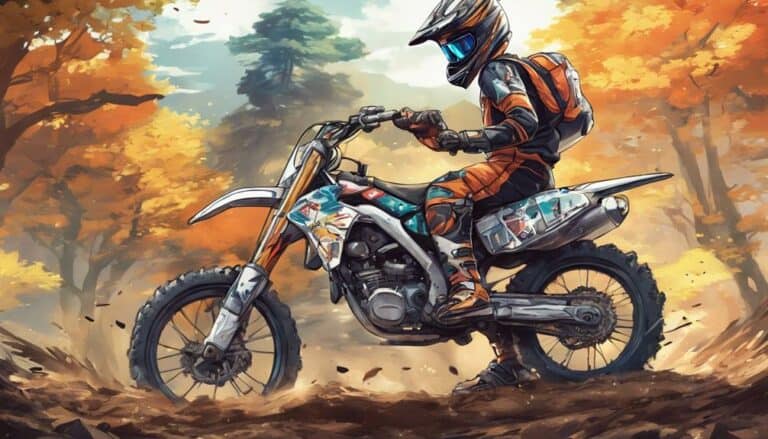Imagine the thrill of tearing through rugged trails, the wind whipping past you as you navigate challenging terrain on your dirt bike. You're in control, but are you truly safe?
Do you have all the necessary precautions in place to guarantee your well-being and that of others around you? Let's explore the critical elements that make up dirt bike safety – from the gear you wear to the techniques you employ, and beyond.
Key Takeaways
- Proper safety gear like helmets, gloves, and boots is crucial for protection.
- Master riding techniques for control, balance, and accident prevention.
- Regular bike maintenance ensures optimal performance and safety.
- Supervision and guidance from experienced individuals are essential for safe dirt bike riding.
Proper Safety Gear
To guarantee maximum safety while riding a dirt bike, it's imperative that you equip yourself with proper safety gear. This includes essential items such as a DOT-approved helmet with eye protection to reduce the risk of head injuries in case of accidents.
Sturdy boots are essential for protecting your ankles, while gloves provide crucial defense for your hands and fingers during rides. Opting for a riding jacket and long pants can help minimize abrasions and injuries in the event of falls or collisions.
Goggles are also recommended, especially if your helmet doesn't have a visor, as they shield your eyes from debris and improve visibility while riding off-road. Investing in quality dirt bike safety gear beyond just a helmet is vital for overall protection and injury prevention.
Riding Techniques
Mastering proper riding techniques on a dirt bike is important for enhancing control, safety, and overall enjoyment of your off-road adventures. Proper braking techniques are essential for maintaining control and avoiding accidents.
When approaching turns, focus on mastering turning and balance skills to guarantee safe and effective dirt bike riding. It's essential to practice these skills in controlled environments to build confidence on various terrains.
Additionally, instilling trail etiquette in riders fosters a safer riding environment for everyone on the trails. Remember, maneuvering turns and maintaining balance are critical for your safety and enjoyment while dirt biking.
Bike Maintenance
When it comes to dirt bike safety, ensuring proper bike maintenance is paramount for a safe and enjoyable riding experience. Here are four essential aspects to focus on:
- Inspect Your Bike: Before each ride, take a few minutes to inspect your bike thoroughly. Check for loose bolts, leaks, or any signs of damage that may affect your safety on the trail.
- Regular Maintenance: Establish a routine maintenance schedule to keep your bike in top condition. This includes oil changes, air filter replacements, and other tasks recommended by your bike's manual.
- Routine Checks: Prioritize regular checks on important components like brakes, tires, and controls. Make sure your brakes are responsive, your tires have adequate tread, and all controls are functioning correctly.
- Basic Maintenance Tasks: Don't overlook simple tasks like chain lubrication and bolt checks. These small efforts can significantly contribute to safer riding conditions and prolong the life of your bike.
Supervision and Guidance
Proper supervision by experienced individuals is essential for ensuring the safety of young dirt bike riders. For inexperienced riders, especially children, having parents or knowledgeable mentors provide guidance is critical. They can teach correct techniques, enforce safety rules, and accompany young riders during their biking activities.
This supervision not only helps prevent accidents but also nurtures the development of skills in young enthusiasts. By being under the watchful eye of adults, young riders can learn in a safe and supportive environment. Whether it's teaching them how to handle turns, obstacles, or jumps, the guidance of experienced individuals plays a significant role in shaping responsible and skilled dirt bike riders.
Parents, in particular, play an important role in instilling good practices and ensuring that their children adhere to safety measures while enjoying their dirt bike adventures.
Emergency Preparedness
To guarantee maximum safety while dirt biking, prioritize emergency preparedness by equipping yourself with a first aid kit and familiarizing yourself with basic first aid techniques. Here are four essential aspects to ponder:
- First Aid Kit: Carry a well-stocked first aid kit tailored to handle common injuries encountered during dirt biking, such as cuts, scrapes, and minor sprains.
- Signal for Help: Learn and practice universal distress signals or carry signaling devices like whistles or signal mirrors to alert others in case of an emergency.
- Know Medical Facilities and Emergency Services: Before setting off on a ride, research and note the locations of the nearest medical facilities and emergency services in the area.
- Charged Cell Phone and Essential Tools: Always carry a charged cell phone with emergency contact numbers saved and bring along essential tools like a multi-tool kit, tire repair equipment, and spare parts for quick fixes in unforeseen situations.
Conclusion
To sum up, dirt bike safety is paramount for a successful and enjoyable riding experience. Did you know that wearing a helmet can decrease the risk of head injury by 69%?
By following proper safety guidelines, practicing safe riding techniques, maintaining your bike, and seeking supervision when needed, you can guarantee a safe and thrilling adventure on your dirt bike.
Remember, safety always comes first. Stay informed, stay prepared, and enjoy the ride!

